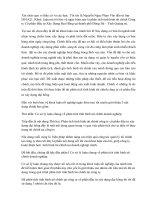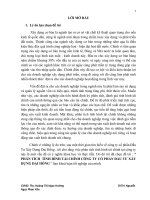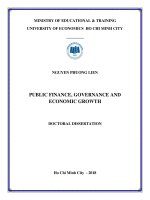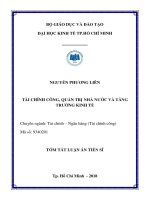TÀI CHÍNH CÔNG, QUẢN TRỊ NHÀ NƯỚC VÀ TĂNG TRƯỞNG KINH TẾ (Luận án tiến sĩ)
Bạn đang xem bản rút gọn của tài liệu. Xem và tải ngay bản đầy đủ của tài liệu tại đây (1.14 MB, 185 trang )
1
MINISTRY OF EDUCATIONAL & TRAINING
UNIVERSITY OF ECONOMICS HO CHI MINH CITY
_________
NGUYEN PHUONG LIEN
PUBLIC FINANCE, GOVERNANCE AND
ECONOMIC GROWTH
DOCTORAL DISSERTATION
Ho Chi Minh City - 2018
2
MINISTRY OF EDUCATIONAL & TRAINING
UNIVERSITY OF ECONOMICS HO CHI MINH CITY
_________
NGUYEN PHUONG LIEN
PUBLIC FINANCE, GOVERNANCE AND
ECONOMIC GROWTH
Specialization: Finance-Banking(Public Finance)
Specialization code: 9340201
DOCTORAL DISSERTATION
SUPERVISOR:
Prof. SU DINH THANH
Ho Chi Minh City - 2018
i
COMMITMENT
I commit that, throughout the whole process, I did this research based on
ethical rules and laws for academic scientific research, including creating research
ideas, conducting the literature review, collecting data, as well as the data analysis
and research interpretation. In addition, I commit that I conducted this study by
myself. The dissertation uses the data and analysis that I did by myself.
Committed by
PhD student
ii
ACKNOWLEDGEMENTS
First, I would like to express my deepest appreciation to my supervisor,
Professor Sử Đình Thành, for his lectures as well as coaching me while I performed
this research. Without his instructions and persistent support, this dissertation would
not have been possible.
Second, I would like to thank all UEH’s lecturers who instructed me in my
research methods courses during my time as a Ph. D. student in the University of
Economics, Ho Chi Minh City. Dr. Trần Thị Tuấn Anh’s expert guidance was
especially valuable for completing my research with clear and logical
interpretations of the methodology.
Third, I am also grateful to my parents, my young sisters, and my sons for
their encouragement in my life. I also wish to express my endless thanks to my love
for his sacrifice and daily care of me.
Finally, last but by no means least, thank you to all my colleagues who
shared with me their useful comments to help complete my publication.
iii
TABLE OF CONTENT
Table of Contents
COMMITMENT ...........................................................................................................i
ACKNOWLEDGEMENTS ........................................................................................ ii
TABLE OF CONTENT ............................................................................................. iii
ABBREVIATIONS ................................................................................................... vii
LIST OF TABLES ..................................................................................................... ix
LIST OF FIGURES ......................................................................................................x
Abstract: ...................................................................................................................... xi
CHAPTER 1 .................................................................................................................1
INTRODUCTION ........................................................................................................1
1.1.
Research background ......................................................................................1
1.1.1. An overview of the status of global economies in the period 1996–2016 .1
1.1.2. The differences of public finance and growth between developed and
developing countries ..............................................................................................5
1.2.
Research motivation .....................................................................................10
1.3.
Research objectives and research questions.................................................14
1.4.
Research scope ..............................................................................................15
1.5.
Research methods .........................................................................................16
1.6.
Research contribution ...................................................................................18
1.7.
Structure of dissertation ................................................................................20
CHAPTER 2: ..............................................................................................................23
LITERATURE REVIEW AND HYPOTHESES DEVELOPMENT .......................23
2.1. Introduction ......................................................................................................23
2.2. Some key concepts ...........................................................................................24
2.2.1. Public finance ............................................................................................24
a) Tax revenue ...................................................................................................25
b) Government expenditure...............................................................................26
iv
2.2.2. Governance and corruption ......................................................................27
2.3 Theoretical literature on the relationship between public finance and
economic growth .....................................................................................................33
2.3.1 Public choice theory ...................................................................................33
2.3.2. Cost-benefit theory of taxation ..................................................................35
2.3.3. Governance theory ....................................................................................37
2.3.4. Economic growth theory: Exogenous and endogenous growth theory ....39
2.4 Empirical literature on relationships among public finance, governance, and
economic growth .....................................................................................................41
2.4.1 Empirical literature on relationships between public finance, and economic
growth......................................................................................................................41
2.4.2. Relationship between tax revenue and government expenditures ............45
2.5 Designing the analytical framework and building hypotheses ........................52
2.6. Summary ..........................................................................................................56
CHAPTER 3 ...............................................................................................................58
METHODS AND RESEARCH DATA.....................................................................58
3.1 Introduction .......................................................................................................58
3.2. Research models ..............................................................................................58
3.2.1 Long-term linkages between public finance, and economic growth .........58
3.2. 2 Tax revenue and expenditure relationship................................................61
3.3 Research data and its source .............................................................................64
3.3.1. Determining appropriate variables and its sources .................................64
3.3.2 Collecting secondary data ..........................................................................67
3. 4 Check balance and essential test ......................................................................68
3. 5 Choose appropriate analytical methods ...........................................................68
3.7. Summary..............................................................................................................77
CHAPTER 4 ...............................................................................................................79
PUBLIC FINANCE, GOVERNANCE, AND ECONOMIC GROWTH: A LONG
RUN ANALYSIS .......................................................................................................79
4.1. Research data ...................................................................................................79
v
4.2. Long-run relationship between public finance and economic growth ............83
4.3.
Linkage between tax revenue and government expenditure........................85
4.4. Results of examining role of governance in modifying effect between public
finance and economic growth .................................................................................86
4.4.1 The role of governance in modifying effect between public finance and
economic growth in developing countries ..........................................................86
4.4.2 The role of governance in modifying effect between public finance and
economic growth in developed countries ............................................................88
CHAPTER 5: ..............................................................................................................93
CONCLUSION, IMPLICATION AND LIMITATION ...........................................93
5.1. Conclusion .......................................................................................................93
5.2. Suggestion to policy makers ............................................................................95
5.3. Research limitation and future research ..........................................................96
LIST OF AUTHOR’S PUBLICATION ....................................................................96
REFERENCES ...........................................................................................................99
APPENDICIES .............................................................................................................1
Table Appendix A1 ...................................................................................................1
List of studied countries ............................................................................................1
Table Appendix A2 ...................................................................................................4
Table Appendix A3 ...................................................................................................8
Table Appendix A4 .................................................................................................14
Table Appendix A5 .................................................................................................17
Table Appendix A6 .................................................................................................18
Table Appendix A7 .................................................................................................19
Table Appendix A8 .................................................................................................20
1. Description of variables ...............................................................................21
2. Correlation matrix ........................................................................................21
3. HT and IPS unit root test results (normal variables) ..................................22
4. Results of co-integration test ........................................................................29
5. Granger test results ......................................................................................30
vi
7. Results of verification of governance role in modifying economic growth by
SUR model ...........................................................................................................31
8. Results of verification of governance role in modifying economic growth by
SGMM ..................................................................................................................38
9. Robustness check with CPI ...........................................................................43
vii
ABBREVIATIONS
Words
GDP
Meanings
Gross Domestic Products
OECD
Organization for Economic Co-operation and
Development.
RGDP
Real GDP per capita
LRGD
Logarithm of Real GDP per capita
Gexp
Government expenditure
Taxrev
Total Tax revenue
RE
Random-Effects
FE
Fixed Effects
OLS
Ordinary Least Square
SGMM
System Generalized Method of Moments
GMM
Generalized Method of Moments
SUR
Seemingly Unrelated Regression
EC
Error Correction
GLS
Generalized Least Square
2SLS
Two-stage Least Square
HT
Harris-Tzavalis (1999) test
IPS
Im-Pesaran-Shin (2003) test
UEH
University of Economics Ho Chi minh City
USA
United States of America
US
United States
UK
United Kingdom
BI
Business International Corporation
ICRG
International Countries Risk Guide
WB
World Bank
IMF
International Moneytary Fund
viii
UNDP
United Nations Development Programme
WDI
World Development Indicators
WGI
World Governance Indicator
WEO
World Economic Outlook
HDI
Human Development Index
CCI
Control of corruption indicator
CPI
Corruption perception index
ECM
Error correction mechanism model
TI
Transparency International
ix
LIST OF TABLES
1. Table 1.1: the global economic growth rebound ..............................................1
2. Table 4.1: Description of variables ………………………………………. 78
3. Table 4.2: Correlation matrix ………………………………………………82
4. Table 4.3: Results of unit root test for a panel with normal data for the whole
sample in 1996-2016………………………………………………………….. 83
5. Table: 4.4: Results of unit root test for a panel with data of first different
values for the whole sample in 1996-2016…………………………………… 84
6. Table 4.5: Westerlund long-run cointegration test results (lrgdp)………… 85
7. table 4.6: Westerlund long-run cointegration test results (tax – exp)……... 87
8. table 4.7: Pairwise Granger test results……………………………………...88
9. Table 4.8: Westerlund long-run cointegration test results (lrgdp; Taxrev, and
Gexp)…………………………………………………………………………...89
10. Table 4.9: The results of verification influence of corruption on public
finance and economic growth in completely 82 developed and developing
countries……………………………………………………………………… 91
11. Table 4.10: The results of verification of the influence of corruption on
public finance and economic growth in 44 developing countries……………. 94
12. Table 4.11: The results of verification of the influence of corruption on
public finance and economic growth in 38 developed countries……………. 95
13. Table 4.12: Robustness check of the corruption role in all 82 countries, 44
developing countries, and 38 developed countries ……………………………97
x
LIST OF FIGURES
1. Figure 1.1: The line trend of global per capita income growth and ratio of tax
revenue and government spending in 1996 and 2016 in 38 developed
countries. ...........................................................................................................2
2. Figure 1.2: the line trend of global per capita income growth and ratio of tax
revenue and government spending in 1996 and 2016 in 44 developing
countries ............................................................................................................4
3. Figure 1.3: the shrink frequency rate ................................................................5
4. Figure 1.4: Line trend of tax revenue – government expenditure – GDP per
capita for whole sample in 1996-2016..............................................................6
5. Figure 1.5: Line trend of tax revenue – government expenditure – GDP per
capita for 44 developing cuntries in 1996-2016 ...............................................6
6. Figure 1.6 : Line trend of tax revenue – government expenditure – GDP per
capita for 38 developed cuntries in 1996-2016. ...............................................7
7. Figure 1.7: The control of corruption indicators in 38 developed countries in
1996 and 2016 ...................................................................................................8
8. Figure 1.8: The control of corruption indicators in 44 developing countries in
1996 and 2016 ...................................................................................................9
9. Figure 2.1: Public sector in the economy………………………………… 26
10. Figure 2.2: Analytical framework of correlation of public fiance, corruption
and economic growth. …………………………………………………
54
xi
Abstract:
This study runs a co-integration and Granger causality tests that corroborate
the existence of long-run co-integration linkages of public finance and economic
growth and a bi-directional causal correlation between tax revenue and government
expenditure. This finding suggests that to control deficits, a government’s decisions
on collecting taxes and government expenditure should be simultaneous. To verify
the effects of governance represented by control of corruption on modifying the
relationship between public finance and economic growth, this study applies a
seemingly unrelated regressions model for the dataset, followed by a robustness
check using a corruption perception index developed by the Transparency
International organization. Measuring public finance by two factors: total tax
revenue and general government expenditure helps this study to confirm the results,
which reveal that the governance has a positive role in the economy. Additionally,
the interaction between governance and tax revenue or government expenditure
affects economy diversely depending on the different economic groups of
developing and developed countries1. For instance, in developing countries, the
interaction between public finance and governance always becomes a beneficial
factor for growth. While in developed countries, this interaction does not have any
meaning with taxation. Therefore, it may increase the efficiency of government
expenditure only. On the first side, the findings also suggest that developing
countries should focus on governance in anti-corruption to increase the
effectiveness of public finance and promote their economic growth. On the other
hand, developed countries should make the decision on public finance separately
with control of corruption.
In this study we call the “developed countries” are high-income countries, which were classified by World
bank and determined as those with a GNI per capita, computed using the World Bank Atlas method. On 1
July 2015, high-income countries gained more than $12,736. This study also calls the “developing countries”
are those countries were classified by World bank as seen as below. Low-income economies are determined
as those with a GNI per capita of $1,045 or less in 2014; Lower-middle-income economies are those with a
GNI per capita of more than $1,045 but less than $4, 125; and upper-middle-income economies are more
than $4,125 but less than $12,736.
1
xii
Keywords: long-term economic growth, co-integration test, governance,
government expenditure, total tax revenue.
JEL Classifications: O40, C52, D73, H20
Luận án đủ ở file: Luận án full









